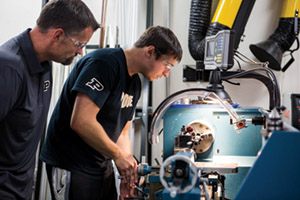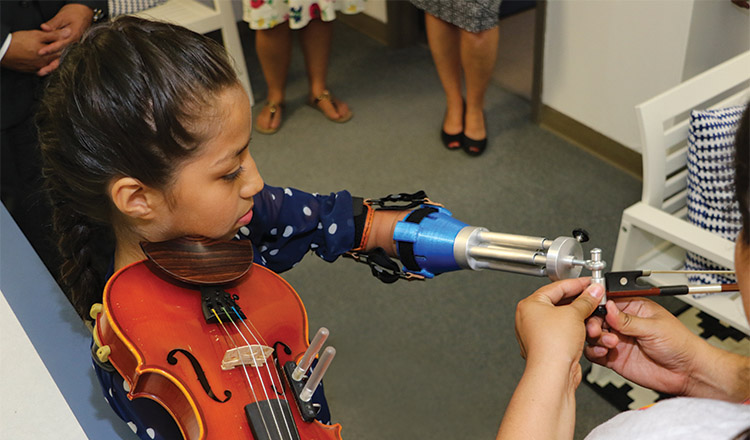Telescoping prosthesis enables 10-year-old girl to bow violin
It’s atypical to see a piano as part of a grade school orchestra ensemble, but that’s exactly what Zayra Vincent encountered when she visited the Burgin Elementary School music room this spring. There, in the back of the Arlignton, Texas, classroom, a smiling 10-year-old girl plucked out notes on the keyboard with one finger.
As the orchestra teacher at Workman Junior High School in Arlington, Texas, Vincent likes to meet the elementary students who will filter up to her class. She quickly learned that Yaretzi Moreno’s family had immigrated to the United States from Mexico about two years ago. The child elected to take orchestra class because she has a passion for music, but her disability presented a barrier to playing a stringed instrument. Yaretzi was born without a left hand.
“I talked with Yaretzi, and I asked her, ‘Do you want to play the violin?’” Vincent says. “She said she would love that. I told her I would do my best to help her. As she ages, it would be very difficult for her to keep going in orchestra in the school system on piano.”
Vincent wasn’t sure how she could help, but she knew she needed to try. It was her husband, Rabon Vincent (T’12), a systems engineer in field tech support at Lockheed Martin, who suggested she reach out to Purdue. The couple followed the Boilermakers during March Madness and saw the coverage of Eric Nauman’s research group and their efforts to build an NCAA-sanctioned elbow brace for injured player Isaac Haas (HHS’18).
First, Vincent had to secure permission from Yaretzi’s parents, who speak limited English. Fortunately, Vincent is fluent in Spanish and was able to talk directly with them. Then, she got in touch with Nauman, a professor of mechanical engineering and head of the Human Injury Research and Regenerative Technologies Laboratory. His team has been developing assistive technologies for 12 years.
“Almost every disability is unique in some sense,” Nauman says. “In Yaretzi’s case, it was an interesting design challenge to create something that would continue to function for her as she grows. It seemed like something we ought to be able to do.”
Yaretzi’s mom, Elizabeth Moreno, cried when Vincent told her the team wanted to design a custom prosthesis for her daughter. “It’s difficult to describe my feelings at that moment because I was overwhelmed by happiness,” Moreno says. “I was very grateful Purdue was willing to help my daughter.”
The lab has about $4,000 in annual funding to develop assistive technologies. Nauman would like to see that total increased to $150,000. Part of that goal includes evolving the development process from being a one-off design project to a nationally renowned repository of assistive technology prototypes. An archive of plans would enable future students to reference previous designs that can be adapted to new clients. It sounds simple, but Nauman insists it’s not a trivial idea. In addition to more funding, it would require additional staffing and a comprehensive curriculum integration to balance research in the lab with education in the classroom, execution of senior design projects, and alignment with the University’s land-grant mission.
“If we could pull it off, we’d see exponential growth,” Nauman says. “We want to work with soldiers and with the elderly. There is a tremendous need in rural communities with farming accidents. There are so many people we could help. In my ideal world, we’d be putting out a new prosthetic every two weeks. That would be amazing.
“We’ve had requests from all over — from as far as South Africa. Many we just can’t fulfill right now. But we should be able to. It fits into our land-grant mission. It’s a wonderful educational experience for these students. It just doesn’t fit into a standard academic budget model.”
Previously, Nauman’s lab developed a prosthetic for a 5-year-old boy with a six-inch femur to help him walk more normally. That design has been adapted to a few more people. They’re currently working on a prosthetic ankle joint to help kids play basketball and run more efficiently and a Braille e-reader for vision-impaired children to begin reading as toddlers rather than waiting until high school to learn. Nauman envisions a future where clients would submit measurements and an MRI, and the team could quickly build a custom-fitted prosthesis from afar.
The graduate students in Nauman’s lab come from various engineering disciplines, and only a few are specifically focused on assistive technologies. Many of the students contributing to the development of these assistive technology prototypes are doing so on top of their regular research and classwork.
“It’s not the focus of our research, but we get to apply our skills to real-life situations and see the impact we have on the community,” says Nicolas Leiva, a graduate research assistant in biomedical engineering. “Our research may be individual, but working on these projects is great bonding for the lab in our free time.”
Leiva worked on finding a means of attaching the brace to Yaretzi’s residual limb without slipping. Jacob McGough (ME’14, MS ME’17), a graduate research assistant in mechanical engineering whose thesis was in biomechanics, designed a new adaptable socket from a soft yet durable polymer. Initially, they used their own wrists to fit the models but discovered they were much too large compared to Yaretzi’s slight limb, which has little muscle mass at its extremity.
“There were a lot of variables to consider,” Leiva says. “She’s going to have a violin bow at the end of it, which is rather heavy. It needs to stay in place through repeated, rapid movement. She may sweat while she’s using it. We wanted to design something that would fit comfortably and wouldn’t slip off.”
Michael Dziekan (BME’17), a graduate research assistant in mechanical engineering, designed the telescoping aluminum arm that was fabricated by Norvin Bruns in the biomedical engineering machine shop. The varying length allows Yaretzi to adjust the prosthesis as she grows.

“It feels pretty good to work on a project like this,” Dziekan says. “It reaffirms your engineering passion.”
Vincent delivered the prototype to Burgin Elementary on the last day of school. “I cried the first time I heard her play,” Elizabeth Moreno says. “It is something we had prayed to God about for a long time. I would like her to be able to reach her maximum potential musically. I always tell her that she can do anything she wants. She just has to do it in a different way.”
The team was able to watch Yaretzi try the prosthesis for the first time via Skype. “Yaretzi played a few notes, and even though it didn’t fit perfectly, that smile will melt you,” Nauman says. “To get that kind of response is wonderful. We can’t wait to hear the music.”
With photos of Yaretzi fitted with the prosthesis and a few additional measurements, the team was able to make final adjustments to produce an improved version in time for her to begin playing with her elementary orchestra this fall.
“These students have risen to another level,” Nauman says. “They are not doing this work as part of their class. It’s not going into their thesis. It’s almost like a responsibility. They know they can help, so they should help. We have tremendous ingenuity in our student population. We need to be able to harness that and put it to use in the community. If we can achieve that, we can help kids all over the world.”

